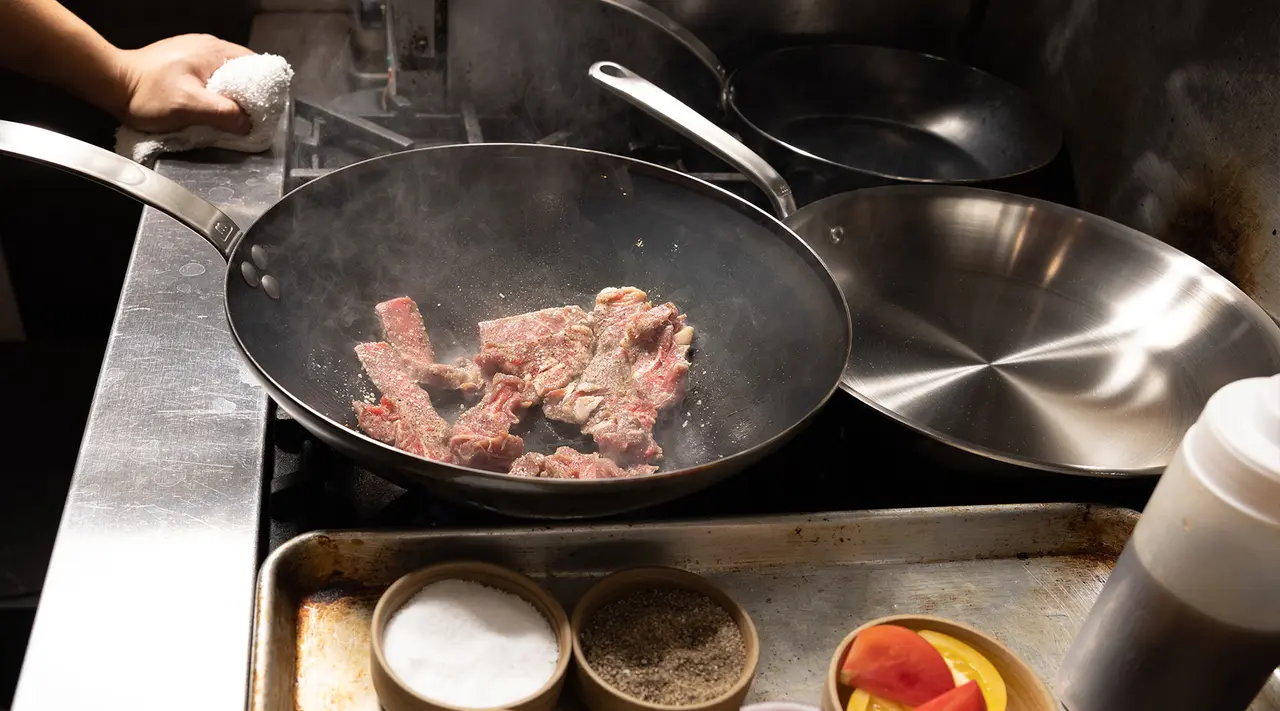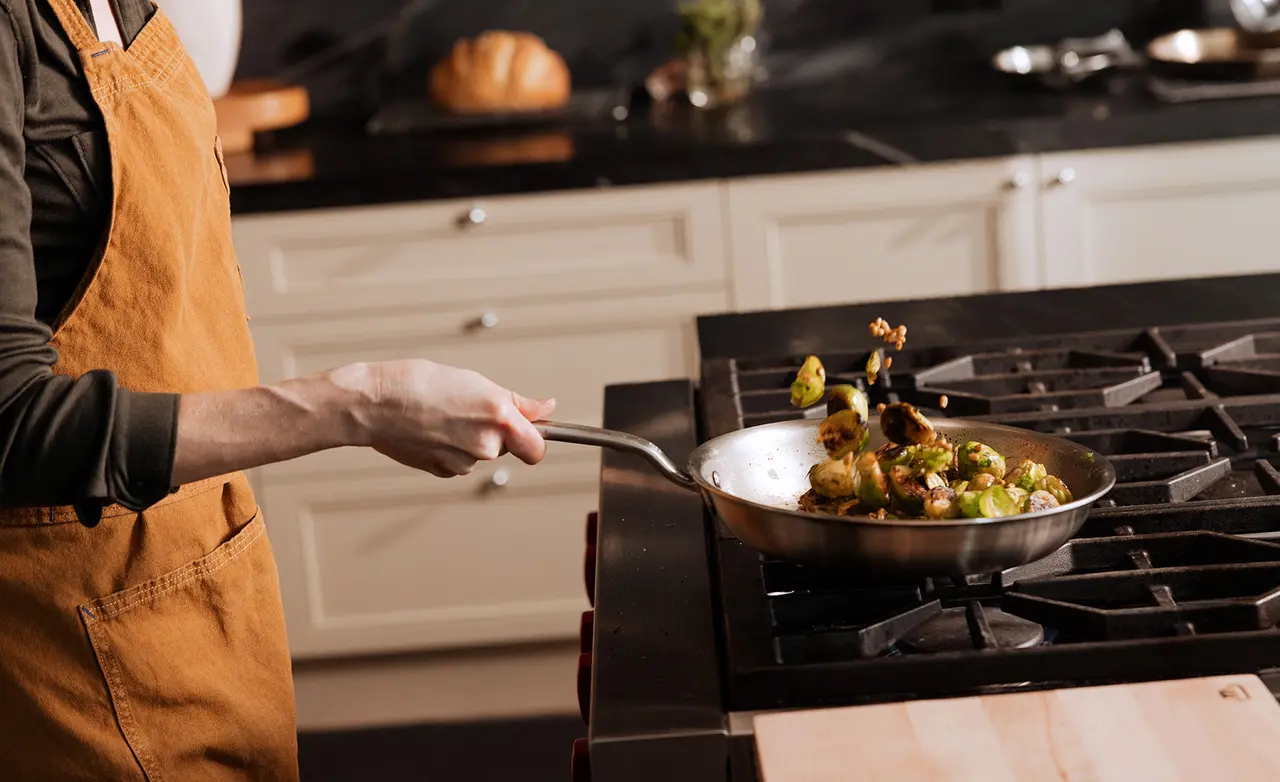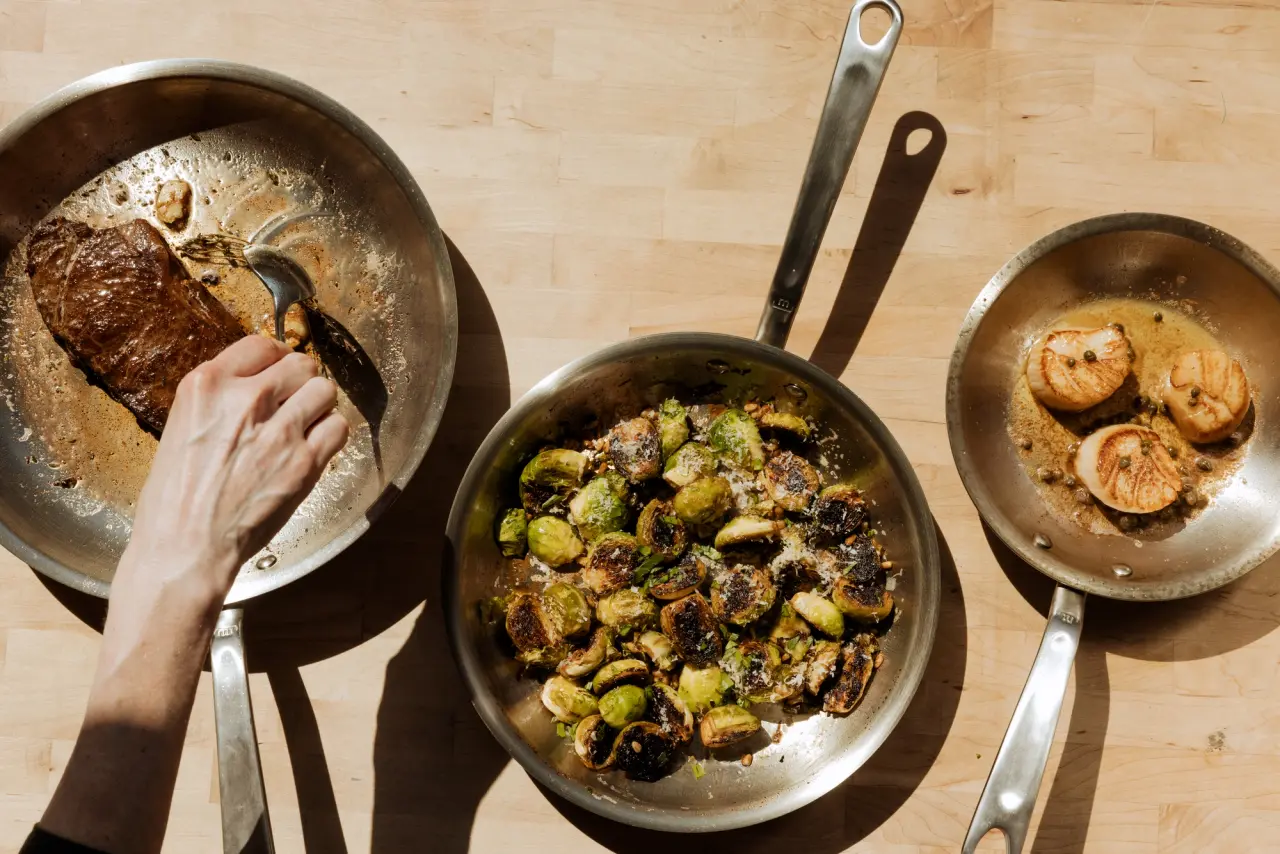Our Wok and our Frying Pan are both constructed from the same material: Carbon Steel. This durable alloy of iron and carbon blends the heat retention and seasoning of cast iron with the lightness and control of Stainless Steel. However, the main difference between these two tools are their shapes.
A traditional Frying Pan has a flat bottom with sloped walls, allowing oil or other liquids to sit evenly on the bottom of the pan. The conical shape of a Wok means that liquids come to rest towards the center of a vessel as opposed to spreading out. Woks are also known for their slanted walls, which trap heat, are perfect for making stir fry, and yield a much faster cooking time.
Here, we will be discussing the similarities and differences between Woks vs. Frying Pans so that you can determine what they are best suited for and whether or not you need both in your kitchen.
What Is a Wok?
A Wok is a traditional Chinese cooking vessel. The word ‘wok’ literally means ‘cooking pot’ in Cantonese. Its distinctive shape serves several purposes. The rounded bottom of the Wok allows both liquid and heat to concentrate in one spot, while the high, sloping walls help retain said heat, yielding a lightning fast cook time.
Our Wok is constructed from Blue Carbon Steel, a relatively lightweight and very durable metal. Like cast iron, Carbon Steel has great heat retention and when properly seasoned, its surface becomes similar to a piece of Non Stick Cookware. Unlike cast iron however, it is not nearly as heavy and because the handle is made from a separate piece of metal, it stays cool much longer.
What Is a Wok Used For?
A Wok’s primary use is for making stir fry. The height of its walls make it ideal for retaining food while quickly stirring and tossing. Additionally, its rounded shape conducts heat very quickly, so it’s ideal for dishes that incorporate seared meats flash fried vegetables.
Intense heat is a key component of wok hei or “breath of wok”, a signature, smoky flavor that is essential to Chinese Wok cooking. While this is damn near impossible to obtain at home because of the temperature difference between home stoves and professional ones, the conductivity of Carbon Steel comes pretty close.
While the bottom of the Wok heats up quickly, the sides provide a natural heat gradient, allowing you to move some ingredients higher so that they don’t scorch. Another great advantage of a Wok’s size is that it can be used to cook a large amount of food, whether that’s cooking down greens or making fried rice for a crowd.
Woks can also be used for deep frying chicken, tempura, and plenty more, as well as steaming dumplings or vegetables if you have a bamboo steamer basket.
Carbon Steel Wok Advantages
Here are some advantages of our Carbon Steel Wok.
- High, sloped walls help our Woks heat up quickly and keep that heat inside.
- Because of its heat retention, cooking in a Wok is usually a speedy process, with stir fry taking less than 10 minutes to come together.
- Once you have seasoned your Wok, it’s surface is naturally non-stick.
- Unlike its cast iron predecessor, Carbon Steel keeps our Wok on the lighter side.
- A Wok’s main purpose is to stir fry and it excels at that.
- Chefs love our Wok because it can handle the heat of a professional stove.
- The high heat and naturally Non-Stick surface means that you need to use less oil in a Wok, therefore making it a healthier option.
Carbon Steel Wok Considerations
Like all cookware, there are some things to consider when using a Carbon Steel Wok.
- Because it cooks at such a high heat, keep a watchful eye on your Wok as you learn to use it or you may end up burning your food.
- Make sure you thoroughly dry your Wok before storing it as Carbon Steel can easily rust.
- Like all Carbon Steel Cookware, your Wok requires seasoning before its first use to create that natural Non-Stick surface.
- Be wary of cooking highly acidic foods in your Wok as it may strip the seasoning. This will not ruin it, but it is a pain to have to re-season and start from scratch.
What Is a Frying Pan?
A Frying Pan, also referred to as a skillet, is a flat-bottomed pan with slightly sloping or flared out sides. These low walls allow for heat to evaporate more quickly, leading to a slower cooking time than the Wok. The flat bottom lets both oil and heat spread out evenly.
Like the Wok, we offer a Carbon Steel Frying Pan (although Non Stick and Stainless options are also available). It performs a lot like a cast iron skillet with great heat retention and a naturally Non-Stick surface but it also takes some of the best qualities from Stainless Steel. Not only is it lightweight, it also heats up quickly and cooks fast.
What Is a Frying Pan Used For?
Depending on the material they are constructed from, Frying Pans are used for a wide variety of cooking techniques, including searing, sautéing, and shallow frying. You can cook almost anything in a Frying Pan from eggs for breakfast to fruit for dessert.
The Carbon Steel Frying Pan lends itself particularly well to searing meat and vegetables because as with the Wok, the Carbon Steel imparts a signature smoky taste and creates beautiful browning.
Carbon Steel Frying Pan Advantages
Here is a list of some advantages of a Carbon Steel Frying Pan.
- Though it weighs significantly less than cast iron, this Frying Pan is just as durable.
- Carbon Steel is great for getting color and crisp on a piece of meat.
- Despite its low sides, Carbon Steel has excellent heat retention.
- Unlike its cast iron counterpart, Carbon Steel heats up quickly.
- This Frying Pan is oven safe up to 1200F, far hotter than a conventional oven is ever able to get.
- Made in France and modeled after French pans, this Frying Pan has a sleek design featuring a Stainless Steel handle that stays cool while the rest of the pan holds its heat.
Carbon Steel Frying Pan Considerations
Here are a few things to take into consideration when using the Carbon Steel Frying Pan.
- Just like the Wok, this Frying Pan will need to be seasoned before its first use.
- If your Frying Pan gets very dirty or rusty, you will have to scrub it out and start from scratch, re-seasoning it.
- Due to its low sides, Frying Pans take a longer amount of time to cook food.
Which Should I Use?
Choosing between a Wok and a Frying Pan is not really about which one is better, but what you are going to be using them for. Try making stir fry in a Frying Pan and you’ll see that while it may be doable, it’s not ideal. There are some things you can’t do—you can’t deep fry in a Frying Pan and you can’t sear a whole steak in a Wok. Professional chefs use both for their respective advantages and the same is likely true in your own home kitchen.
Ultimately, when it comes to whether or not you need both a Wok and a Frying Pan in your kitchen, it depends on what you are cooking. Having both allows you to sear and stir fry, although as we’ve outlined above, neither pan is only good for one thing. We can’t recommend one over the other, unless it comes to specific dishes or techniques.
Having the freedom to choose between what you’re going to make breeds creativity, and if you have both a Wok and a Frying Pan in your kitchen, you are already halfway to creating a wealth of amazing dishes.
























